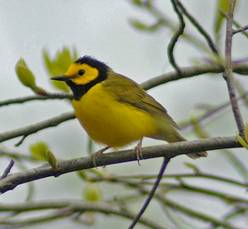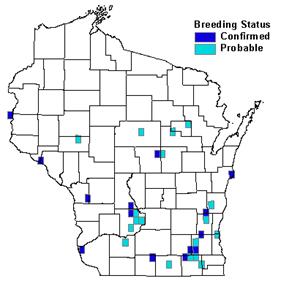Photo by Dennis Malueg


Status/Protection
- Global Rank: G5 Key to global and state ranks
- State Rank: S2S3B
- WBCI Priority: SGCN, State Threatened
Population Information
Federal BBS information can be obtained at http://www.mbr-pwrc.usgs.gov/bbs/bbs.html by clicking on Trend Estimates and selecting the species in question. All estimates are for 1966-2005.
*Note: There are important deficiencies with these data. These results may be compromised by small sample size, low relative abundance on survey route, imprecise trends, and/or missing data. Caution should be used when evaluating this trend.
- Federal Breeding Bird Survey: non-significant increase
- Federal Breeding Bird Survey (WI): N/A
- Federal Breeding Bird Survey (BCR 23): non-significant increase*
- Federal Breeding Bird Survey (BCR 12): N/A
- WSO Checklist Project: stable (1983-2007)
Life History
- Breeding Range: Southern Wisconsin south to eastern Texas east to the Atlantic Coast (Evans Ogden and Stutchbury 1994).
- Breeding Habitat: Oak, Central Hardwood, Northern Hardwood, mature deciduous woodlands and pine plantations.
- Nest: Cup, typically < 1.5m above ground in shrub (Evans Ogden and Stutchbury 1994).
- Nesting Dates: Eggs: late May to mid-July (Bielefeldt and Rosenfield 2006).
- Foraging: Foliage glean, hawking, ground glean (Ehrlich et al. 1988).
- Migrant Status: Neotropical migrant.
- Habitat use during Migration: Dense gulf-coastal woodlands and woodlands similar to nesting habitats.
- Arrival Dates: Late April to early June (Robbins 1991).
- Departure Dates: Mid-August to late September (Robbins 1991).
- Winter Range: Southern and eastern Mexico, Central America.
- Winter Habitat: Mature hardwood forests to shrubby habitats.
Habitat Selection
The Hooded Warbler in Wisconsin breeds in shrub-dominated openings within extensive mature deciduous forest stands (Evans Ogden and Stutchbury 1994). It is an area-sensitive species with minimum size requirements estimated from 100-600 hectares for Wisconsin and Illinois (Blake and Karr 1984, Temple 1988, Mossman and Hoffman 1989). Bielefeldt and Rosenfield (2001) found nest sites in both mature and mid-successional woodlands and deciduous edges around conifer plantations. Bielefeldt and Rosenfield (1994) documented numerous nests in blackberry thickets of red pine stands, an unusual habitat for this species, in the southern unit of the Kettle Moraine State Forest. In their study, the most common nest supports were buckthorn, raspberries, and blackberries. Canopy disturbances such as trails, logging, fire, and roads can provide the required structural habitat features for Hooded Warblers. Mossman and Lange (1982) also reported this species associated with forest openings caused by two-lined chestnut borers.
In the winter range from gulf-coastal Mexico to Panama, male Hooded Warblers segregate from females with males frequenting mature forest and females occurring in scrub, low vegetation, and secondary forests (Lynch et al. 1985, Lopez Ornat and Greenberg 1990, Evans Ogden and Stutchbury 1994). In the U.S. Virgin Islands, Askins et al. (1992) found Hooded Warblers only in moist forests.
Habitat Availability
Hooded Warblers are concentrated in the southern, particularly the southeastern, region of Wisconsin (Robbins 1991, Evans et al. 1994, Bielefeldt and Rosenfield 2006), where it nests only in the most extensive forest tracts (Ambuel and Temple 1983). This preference for large forest tracts limits the number of breeding opportunities for Hooded Warbler in the state, where the species is on the extreme northwestern edge of its range. Forest fragmentation and development pressures have reduced the amount of suitable habitat available for this species in Wisconsin (WDNR 2005).
Population Concerns
Due to the rarity of the Hooded Warbler in Wisconsin, it is not sufficiently known whether the population is stable. This species is rarely recorded on either the Wisconsin routes of the Breeding Bird Survey or the Wisconsin Checklist Project (Rolley 2005, Sauer et al. 2005). Intensive, targeted survey efforts would be necessary to obtain better population trend data. Robbins (1991) cites this species as a rare summer resident south and east. Prior to the Wisconsin Breeding Bird Atlas, there were only six known breeding records statewide. However, the Atlas work significantly improved our knowledge of this species breeding status by confirming breeding activity in 13 counties and documenting probable or possible activity in 15 additional counties (Bielefeldt and Rosenfield 2006).
Forest fragmentation and subsequent increases in predation and Brown-headed Cowbird parasitism likely are detrimental to the Hooded Warbler (Brittingham and Temple 1983, Evans Ogden and Stutchbury 1994). Parasitism rates have been as high as 44% in Wisconsin (Bielefeldt and Rosenfield 2001) and 75% in Illinois (Evans Ogden and Stutchbury 1994). Deforestation of winter habitats also may be a concern but few data are available (Powell and Rappole 1986, Evans Ogden and Stutchbury 1994).
Recommended Management
Unfortunately, literature regarding the management of this species in the southern U.S., where the species prefers swamps and flooded forests, may not provide useful recommendations for Hooded Warblers nesting in upland forests of Wisconsin. Management efforts for Hooded Warblers in Wisconsin should focus on protecting existing breeding habitat, particularly large tracts of mature deciduous forest. Since many large forested areas in southern Wisconsin are not publicly owned, the application of sustainable forest management practices is necessary to encourage the vertical complexity and shrubby understory required by this species (WDNR 2005). Selective logging in less mature forests can create favorable undergrowth deep within large tracts of forest (Brawn et al. 2001). Managers may need to consider reducing deer densities in designated conservation areas for this species (WDNR 2005). Conservation and management strategies for this species should be focused in the following ecological landscapes: Central Lake Michigan Coastal, Forest Transition, Southeast Glacial Plains, Western Coulee and Ridges, and Western Prairie (WDNR 2005). Within these landscapes, important sites for Hooded Warblers include Wyalusing Park State Natural Area, Tiffany Wildlife Area, Cook Arboretum in Rock County, the Baraboo Hills (Mossman and Lange 1982), Kettle Moraine State Forest (Volkert 1992), and the southeastern counties.
Research Needs
Bielefeldt and Rosenfield (2001) substantially advanced our understanding of this species in Wisconsin, but much about our population remains to be learned. Population status needs clarification, while data on site fidelity and habitat selection of male Hooded Warblers could help to guide management practices. The effects of invasive vegetation, particularly garlic mustard and buckthorn, also are not known.
Information Sources
- Cornell Lab of Ornithology species account: www.birds.cornell.edu/bfl/speciesaccts/hoowar.html
- Chequamegon National Forest Bird Survey (NRRI) species account: http://www.nrri.umn.edu/mnbirds/accounts/HOWAa2.htm
- Patuxent Bird Identification Center: www.mbr-pwrc.usgs.gov/id/framlst/i6840id.html
- North American Breeding Bird Survey: http://www.mbr-pwrc.usgs.gov/bbs/bbs.html
- Temple S.A., J.R. Cary, and R. Rolley. 1997. Wisconsin Birds: A Seasonal and Geographical Guide. Wisconsin Society of Ornithology and Wisconsin Department of Natural Resources, Madison, WI.
- Robert N. Rosenfield, Department of Biology. University of Wisconsin - Stevens Point.
- Wisconsin Breeding Bird Atlas: http://www.uwgb.edu/birds/wbba/
References
- Ambuel, B. and S.A. Temple. 1983. Area dependent changes in the bird communities and vegetation of southern Wisconsin forests. Ecology 64: 1057-1068.
- Askins, R.A., D.N. Ewert, and R.L. Norton. 1992. Abundance of wintering migrants in fragmented and continuous forests in the U.S. Virgin Islands. Pp 197-206 In: Hagan, J. M. III, and D. W. Johnston [eds.]. Ecology and conservation of Neotropical migrant landbirds. Smithson. Inst. Press, Washington, D.C.
- Bielefeldt, J. and R.N. Rosenfield. 1994. Summer birds of conifer plantations in southeastern Wisconsin. Passenger Pigeon 56: 123-135.
- Bielefeldt, J. and R.N. Rosenfield. 2001. Nest site habitats and breeding biology of Hooded Warblers in southeastern Wisconsin. The Passenger Pigeon 63(4): 243-251.
- Bielefeldt, J. and R.N. Rosenfield. 2006. Hooded Warbler. In Atlas of the Breeding Birds of Wisconsin. (N.J. Cutright, B.R. Harriman, and R.W. Howe, eds.) The Wisconsin Society for Ornithology, Inc. 602pp.
- Blake, J. G., and J. R. Karr. 1984. Species composition of bird communities and the conservation benefit of large versus small forests. Biol. Cons. 30: 173-187.
- Brittingham, M.C., and S.A. Temple. 1983. Have cowbirds caused forest songbirds to decline? BioScience 33: 31-35.
- Evans Ogden, L.J., and B.J. Stutchbury. 1994. Hooded Warbler. The Birds of North America, No. 110 (A. Poole and F. Gill, eds.). The Birds of North America, Inc., Philadelphia, PA.
- Lopez Ornat, A. and R. Greenberg. 1990. Sexual segregation by habitat in migratory warblers in Quintana Roo, Mexico. Auk 107:539-543.
- Lynch, J.F., E.S. Morton, and M.E. Van der Voort. 1985. Habitat segregation between the sexes of wintering Hooded Warblers (Wilsonia citrine). Auk 102: 714-721.
- Mossman, M.J. and R.M. Hoffman. 1989. Birds of southern Wisconsin upland forests. Passenger Pigeon 51: 343-358.
- Mossman, M.J. and K.I. Lange. 1982. Breeding birds of the Baraboo Hills, Wisconsin: Their history, distribution and ecology. Wis. Dep. Nat. Resour. and Wis. Soc. Ornithol., Madison.
- Powell, G.V.N., and J.H. Rappole. 1986. The Hooded Warbler. In Audubon Wildlife Report 1986, R. L. Di Silvestro, ed. 827-853. National Audubon Society, New York.
- Robbins, S. D., Jr. 1991. Wisconsin birdlife: Population and distribution past and present. Madison, WI: Univ. Wisconsin Press.
- Rolley, R. 2005. Wisconsin Checklist Project. http://dnr.wi.gov/org/land/wildlife/harvest/reports/07checklist.pdf
- Sauer, J.R., J.E. Hines, and J. Fallon. 2005. The North American Breeding Bird Survey, Results and Analysis 1966 - 2005. Version 6.2.2006. USGS Patuxent Wildlife Research Center, Laurel, MD.
- Temple, S.A. 1988. When is a bird’s habitat not habitat? Passenger Pigeon 50(1): 37-41.
- Volkert, W.K. 1992. Survey of the birds of the northern Kettle Moraine region. Passenger Pigeon 54: 137-145.
- Wisconsin Department of Natural Resources (WDNR). 2005. Wisconsin’s Strategy for Wildlife Species of Greatest Conservation Need. Madison, WI.
Contact Information
- Compiler: Tom Klubertanz, tklubert@uwc.edu
- Editors: Kim Kreitinger, K.Kreitinger@gmail.com
